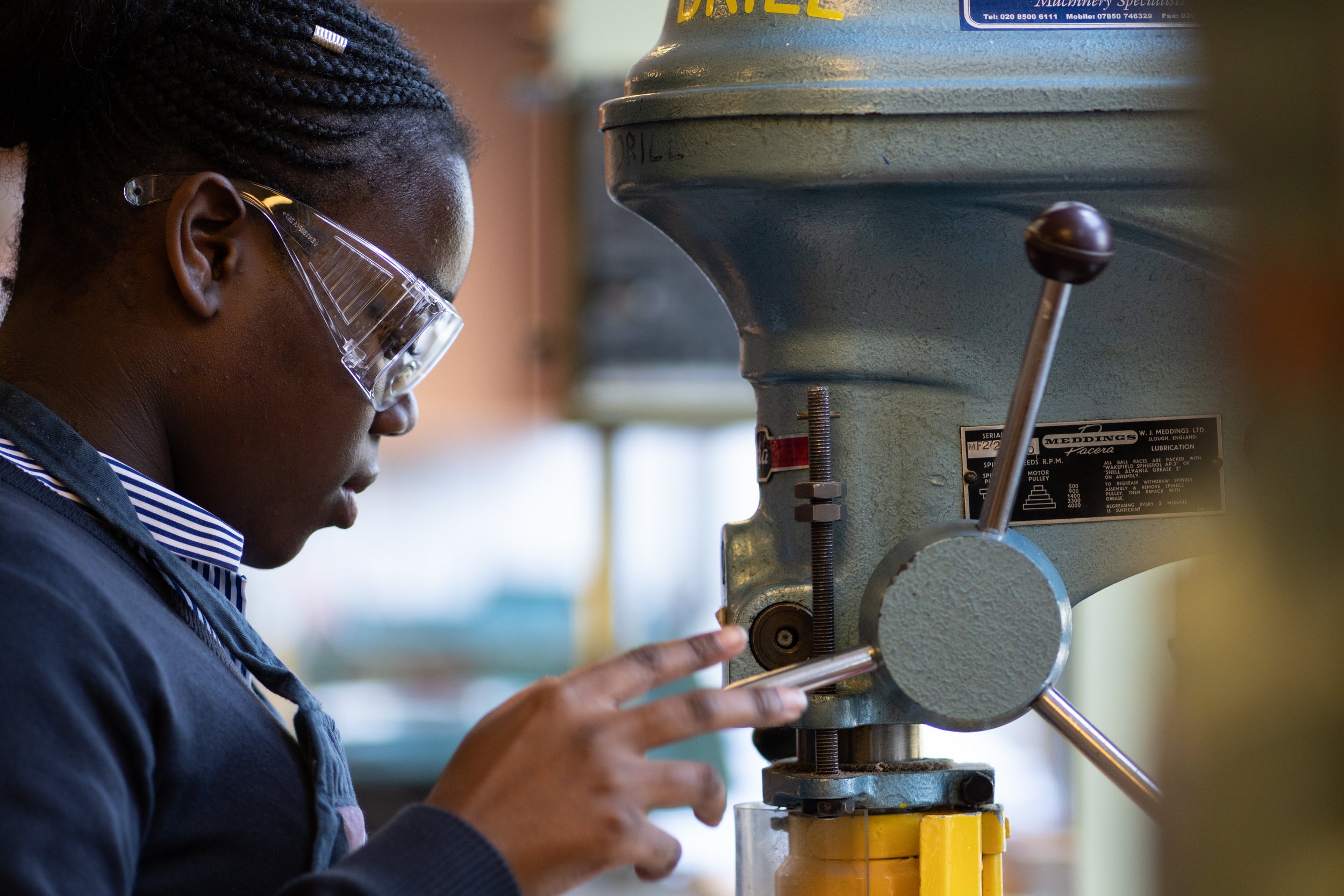
DESIGN AND TECHNOLOGY
Overview Of The Subject
Design and technology is an inspiring, rigorous and practical subject. Using creativity and imagination, pupils design and make products that solve real and relevant problems within a variety of contexts, considering their own and others’ needs, wants and values. They acquire a broad range of subject knowledge and draw on disciplines such as mathematics, science, engineering, computing and art. Pupils learn how to take risks, becoming resourceful, innovative, enterprising and capable citizens. By studying design and technology, they will gain transferable skills, such as using initiative, being organised, being analytical, good communication, being innovative and good teamwork. Through the evaluation of past and present design and technology, they develop a critical understanding of its impact on daily life and the wider world. Design and technology education makes an essential contribution to the creativity, culture, wealth and well-being of the nation.
Aims Of The Curriculum/Curriculum Intent
Design and technology aims to ensure that all pupils:
develop the creative, technical and practical expertise needed to perform everyday tasks confidently and to participate successfully in an increasingly technological world
build and apply a repertoire of knowledge, understanding and skills in order to design and make high-quality prototypes and products for a wide range of users
critique, evaluate and test their ideas and products and the work of others.
Curriculum Content KS3
Throughout Key Stage 2, pupils engage in a range of designing and making projects. They may work individually or as part of a team. They think about what products are used for, the needs of the consumer and how it meets them. Pupils at KS2 develop knowledge, skills and understanding in planning and communicating ideas. They decide on what their design needs to achieve, considering the needs of people who will use it. Pupils can communicate their design ideas in different ways. Pupils learn appropriate tools and techniques for making their product. At Key Stage 2, pupils measure, cut, shape and assemble materials and components accurately. Evaluating their work and that of others is an important area that pupils engage with.
Through Key Stage 3, through a variety of creative and practical activities, pupils will be taught the knowledge, understanding and skills needed to engage in an iterative process of designing and making. They will work in a range of domestic and local contexts, such as the home, health, leisure and culture, and industrial contexts, such as engineering, manufacturing, construction, energy, and fashion. When designing and making, pupils will be taught to:
Design
use research and exploration, such as the study of different cultures, to identify and understand user needs
identify and solve their own design problems and understand how to reformulate problems given to them
develop specifications to inform the design of innovative, functional, appealing products that respond to needs in a variety of situations
use a variety of approaches, such as biomimicry and user-centred design, to generate creative ideas and avoid stereotypical responses
develop and communicate design ideas using annotated sketches, detailed plans, 3-D modelling, oral and digital presentations and computer based tools.
Make
select from and use specialist tools, techniques, processes, equipment and machinery precisely, including computer-aided manufacture
select from and use a wider, more complex range of materials, components and ingredients, taking into account their properties.
Evaluate
analyse the work of past and present professionals and others to develop and broaden their understanding
investigate new and emerging technologies
test, evaluate and refine their ideas and products against a specification, taking into account the views of intended users and other interested groups
understand developments in design and technology, its impact on individuals, society and the environment, and the responsibilities of designers, engineers and technologists
Technical knowledge
understand and use the properties of materials and the performance of structural elements to achieve functioning solutions
understand how more advanced mechanical systems used in their products enable changes in movement and force
understand how more advanced electrical and electronic systems can be powered and used in their products, such as circuits with heat, light, sound and movement as inputs and outputs
apply computing and use electronics to embed intelligence in products that respond to inputs such as sensors, and control outputs such as actuators, using programmable components such as microcontrollers.
Projects At Key Stage 3
Year 7
Clock Project
Pupils will make a clock from Acrylic plastic, plywood and mild steel. Through the project pupils will learn:
The types and the properties of plastics, woods, and metals.
How to use materials sensibly.
How to evaluate existing products.
How to consider environmental, social, ethical and cultural issues in their designing and making.
How to generate and develop design ideas.
How to use CAD to design their ideas (2D Design).
How to use vinyl cutter.
How to use hand and power tools accurately and safely to shape and combine materials to make a freestanding clock.
How to evaluate and improve their product.
Pupils will be assessed on:
Their classwork folder, including finished practical product.
Homework/extended work folder.
One subject knowledge tests.
Pupils will be provided with a mark scheme so they can evaluate their work.
Year 8
Bi-Plane Project
Pupils will make a Bi-Plane from pine and plywood. Through the project pupils will learn/enhance understanding/skills on:
How toys help children’s development and what makes a good toy.
The types and the properties of plastics, woods, metals and smart and modern materials.
How to use materials sensibly.
How to consider environmental, social, ethical and cultural issues in their designing and making
How to evaluate existing products.
How to use a theme to influence their design.
How to generate and develop design ideas.
How to use CAD to design their ideas. (2D Design and Sketch Up).
How to use vinyl cutter.
How to use vacuum former.
Linear, rotary, reciprocating and oscillating movements.
How to use hand and power tools accurately and safely to shape and combine materials to make a child toy.
How to evaluate and improve their product.
Pupils will be assessed on:
Their classwork folder, including finished practical product.
Homework/extended work folder.
One subject knowledge tests.
Pupils will be provided with a mark scheme so they can evaluate their work.
Year 9
Gadget Tidy Project
Pupils will make a Gadget Tidy from pine, acrylic and plywood. Through the project pupils will learn/enhance understanding/skills:
The types and the properties of plastics, woods, metals, composites and smart and modern materials.
Materials finishes
Materials stock form
How to use materials sensibly
How to evaluate existing products
How to consider environmental, social, ethical and cultural issues in their designing and making
Using a theme to influence their design.
How to generate and develop design ideas.
How to use CAD to design your ideas. (2D Design and Sketch Up).
How to use vinyl cutter.
How to use hand and power tools accurately and safely to shape and combine materials to make a desk/gadget tidy.
Vacuum forming, laser cutting and 3D printing.
Levers, Linkages and Rotary systems
How to evaluate and improve their product.
Pupils will be assessed on:
Their classwork folder, including finished practical product.
Homework/extended work folder.
One subject knowledge tests.
Pupils will be provided with a mark scheme so they can evaluate their work.
Design & Technology GCSE
Aims Of The Curriculum/Curriculum Intent
GCSE Design and Technology will prepare students to participate successfully in a technological world. Students will gain awareness and learn from wider influences on Design and Technology including historical, social, cultural, environmental and economic factors. Students will get the opportunity to work creatively when designing and making and apply technical and practical expertise.
Specification
Exam board: AQA
Specification code: 8552
Exam outline: All GCSE assessment is in Year 11
Non-Exam-Assessment (100 marks): This will make up 50% of pupils’ final grade in the GCSE.
Written Exam (100 marks): This will make up 50% of pupils’ final grade in the GCSE.
Curriculum Content KS4
Year 10
Design and Technology follows the AQA course. Design and Technology until June of Year 10 is all about preparation. Pupils will be investigating and practising manufacturing techniques, a wide range of materials (woods, plastics, metals, papers/boards, smart materials, modern materials, and textiles) and the design process.
They are going to work on project in order to practice how a portfolio can be generated for GCSE no-exam assessment and enhance their understanding about materials and processes.
Homework will be set on a regular basis and will directly link to the theory and practical elements within the course.
What pupils learn by June of Year 10 will go on to define the work that they will start in June of Year 10 and finish by Christmas of Year 11.
Year 11
Non-Exam-Assessment (100 marks)
In June of Year 10 pupils are given a choice of context in which they will produce a product alongside a 20 pages portfolio explaining in detail investigation into the design context, research and generating ideas, developing those initial ideas and modelling producing a mock-up or clear detailed intentions of prototypes. This project will make up 50% of your final grade in the GCSE.
Written Exam (100 marks)
After completing non-exam assessment pupil will start exam preparation. The GCSE examination is one 2 hour paper covering a wide range of areas. Its split into 3 sections; core technical principals (multiple choice questions on a wide range of topics), specialist technical principals
(Longer, 2-5 mark questions) and designing and making principals (Mixture of short and long responses, including an extended 12 mark design question). This will make up 50% of pupils’ final grade in the GCSE.
Year 11 Assessment
GCSE Mock Written examination, 2 hours
GCSE Pre-Published Examination, 2 hours
Revision
Class notes
Text books
Revision booklets
Practical experiments
Homework booklets
Questions, videos and design and technology websites
After Key Stage 4
Students taking Design & Technology are able to develop their skills further by working towards A Level Engineering, Fashion and Textiles and Product Design. It also prepares students for study towards BA, BEng and BSC degree courses in Architecture and Building Studies, Design (Including Digital and Interactive, Fashion and Textiles, and Product Design), and Engineering(including Aerospace, Civil, Electrical and Mechanical). There is a wide range of career opportunities in Design, Manufacturing, Construction or Engineering.
